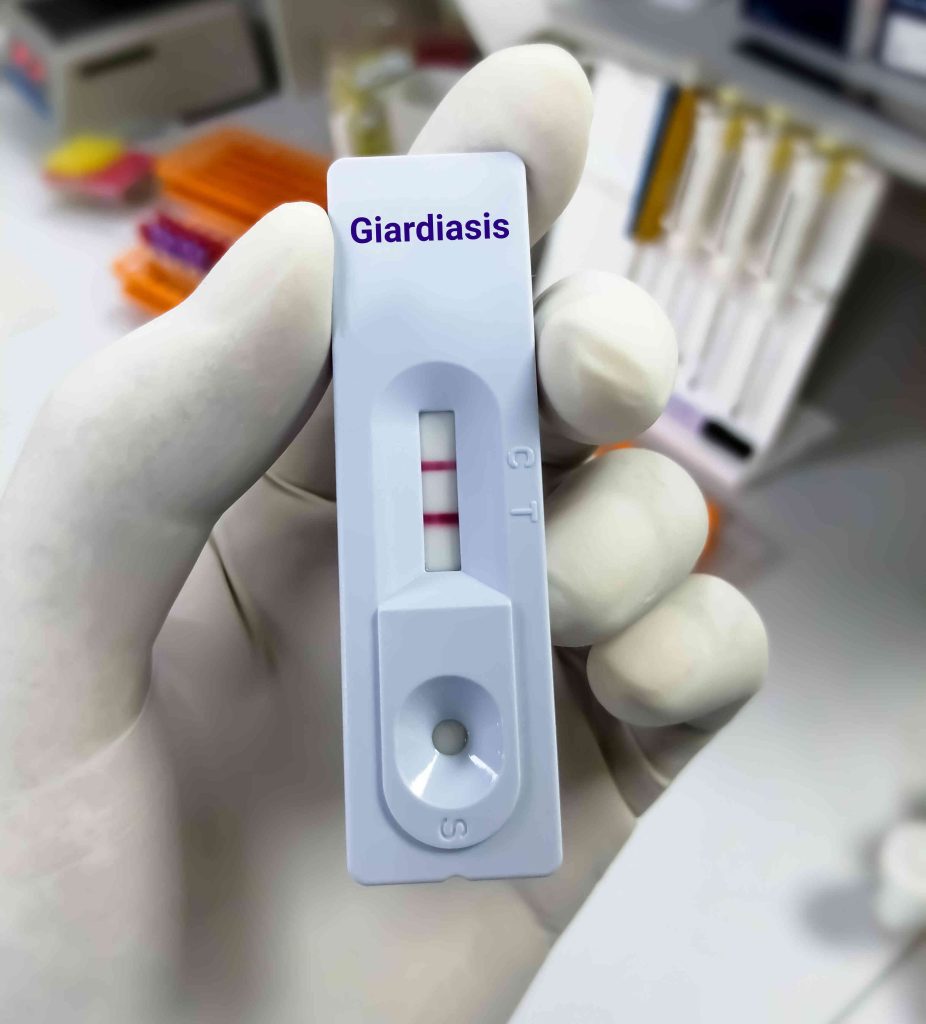Many pet owners have heard of Giardia or Toxoplasmosis, yet are often unsure what these infections actually are, what symptoms they may cause, and how they can be prevented. Both conditions are caused by protozoan parasites. These parasites are not worms, bacteria or viruses, but single-celled organisms that can infect cats, dogs, and other animals. In this article we will take a closer look at these common protozoan parasites, how they spread, the signs to watch for, and what you can do to help keep your pets healthy.
Giardia Lamblia / Giardia
Giardia lamblia is a common protozoan parasite found in both cats and dogs, and it causes an intestinal infection known as Giardiasis (often simply called Giardia). It does not only affect dogs and cats, as many other animals can become infected, and humans can also catch it. Giardia lamblia has two forms: a fragile feeding form that lives inside the intestine of the infected animal, and a hardy cyst form that is shed in the faeces. These cysts are extremely resilient and can survive in the environment for several months.
Not all infected pets show symptoms. When signs do appear, they typically include foul-smelling diarrhoea or vomiting. Some animals may also experience weight loss, intermittent diarrhoea (which comes and goes), and fatty stools. The stool may appear greenish and can occasionally contain traces of blood. Giardia is usually not life-threatening, but it can be more serious for very young, very old, or immunocompromised pets. Animals can carry and spread Giardia without showing any symptoms themselves.
Pets become infected when they ingest cysts from contaminated soil or water. Once inside the body, the cysts activate, transform into the feeding form, and attach to the intestinal wall. Animals that are already unwell or stressed are more susceptible. The higher the number of cysts in the environment, and the more the pet ingests, the greater the risk of infection. Outbreaks are especially common in high-stress, high-density environments such as shelters, where many animals live closely together and contamination builds up quickly.

Giardia can be treated with medication. Alongside treatment, a strict cleaning and hygiene protocol is essential to prevent reinfection from cysts that may still be present in the environment. Always clean up your pet’s stool straight away, bathe your pet regularly to remove any cysts that may have become trapped in their fur, and wash their bedding frequently and thoroughly clean their living area.
For environmental disinfection, you can use chlorine bleach diluted at 1:32 or 1:16, which is equal to 1 to 2 cups per gallon of water (60–120 ml/L). Make sure to dry all areas well, as Giardia cysts are vulnerable to drying.
Prevention relies on good hygiene practices, such as regular cleaning of the environment, bathing your pet when infected, and washing hands to avoid ingesting contaminated material such as soil, food, or water.
Toxoplasma Gondii / Toxoplasmosis
Toxoplasmosis is caused by the one-celled protozoan parasite Toxoplasma gondii. It is an infection that almost all warm-blooded animals can contract, including dogs and cats. Humans can also become infected, and while most healthy adults will not develop health problems unless they are immunocompromised, the infection is dangerous during pregnancy because it can affect the foetus. When a foetus becomes infected, this can lead to hearing and vision loss and developmental disabilities later in life.
Cats are the primary host for Toxoplasma gondii. Dogs and humans can contract the infection but do not shed the oocysts in their faeces, making them intermediate hosts. Intermediate hosts cannot shed cysts in the stool but can pass on the infection if their infected meat is eaten. This type of transmission occurs when cats eat infected rodents or when humans consume undercooked contaminated meat from livestock.
An infection with Toxoplasma gondii rarely causes symptoms in healthy adults unless toxoplasmosis develops. This is more likely in very young animals or animals with weakened immune systems. The most common symptoms are lethargy, loss of appetite, and fever. Other symptoms can occur depending on whether the infection is chronic or acute and may include pneumonia, jaundice, blindness, personality changes, circling, head pressing, difficulty eating, seizures, and incontinence. Toxoplasmosis can be treated with antibiotics.
Prevention in humans involves good hygiene practices such as washing hands, cleaning litter boxes straight away, and ensuring food is properly washed or cooked. Pregnant individuals should avoid cleaning litter boxes if possible. Prevention in pets includes removing stool in a timely manner and preventing them from eating contaminated meat, such as rodents.
Important note regarding toxoplasmosis and being pregnant
Some people consider placing their cats for adoption once they are pregnant or planning to become pregnant because of the risk toxoplasmosis may pose to their unborn baby. This is completely unnecessary. The chance of picking up Toxoplasma gondii from your cat is incredibly small, especially if your cat lives strictly indoors. Indoor cats do not have access to infected rodents and are unlikely to come into contact with contaminated soil or faeces.
Cats that do become infected only shed the T. gondii oocysts for a very short period after infection, usually around two weeks, and in most cases only the first time they are exposed. The likelihood that your cat will experience their first infection during the exact period you are pregnant is extremely low.
It also takes around 24 hours for oocysts in the stool to become infectious. By removing stool straight away, wearing gloves, and washing your hands, you can significantly reduce the risk of infection. Cat bites, scratches, and stroking an infected cat are very unlikely to transmit the parasite because it is not present in the fur or saliva.
The main source of toxoplasmosis infection in humans is eating undercooked contaminated meat or consuming unwashed, or insufficiently washed, infected fruits and vegetables. Gardening without gloves and insufficient hand washing afterwards is another common route of exposure.
Conclusion
Through this article, we hope to have informed pet owners about Giardia and Toxoplasmosis in pets, how to recognise an infection, and what can be done to prevent a reinfection. We also hope it has helped clear up any confusion about toxoplasmosis and pregnancy, so pet owners can feel reassured and well prepared.
If you would like to know more about our pet care services feel free to contact our team. They will be happy to help.

